Abstract
Lactation is the most energy-efficient way to provide for the dietary needs of young mammals, their mother's milk being actively protective, immunomodulatory, and ideal for their needs. Intrauterine mammary gland development in the human female is already apparent by the end of the sixth week of gestation. During puberty and adolescence secretions of the anterior pituitary stimulate the maturation of the graafian follicles in the ovaries and stimulate the secretion of follicular estrogens, which stimulate development of the mammary ducts. Pregnancy has the most dramatic effect on the breast, but development of the glandular breast tissue and deposition of fat and connective tissue continue under the influence of cyclic sex-hormone stimulation. Many changes occur in the nipple and breast during pregnancy and at delivery as a prelude to lactation. Preparation of the breasts is so effective that lactation could commence even if pregnancy were discontinued at 16 weeks.
Following birth, placental inhibition of milk synthesis is removed, and a woman's progesterone blood levels decline rapidly. The breasts fill with milk, which is a high-density, low-volume feed called colostrum until about 30 hours after birth. Because it is not the level of maternal hormones, but the efficiency of infant suckling and/or milk removal that governs the volume of milk produced in each breast, mothers who permit their infants to feed ad libitum commonly observe that they have large volumes of milk 24-48 hours after birth. The two maternal reflexes involved in lactation are the milk-production and milk-ejection reflex. A number of complementary reflexes are involved when the infant feeds: the rooting reflex (which programmes the infant to search for the nipple), the sucking reflex (rhythmic jaw action creating negative pressure and a peristaltic action of the tongue), and the swallowing reflex. The infant's instinctive actions need to be consolidated into learned behaviour in the postpartum period when the use of artificial teats and dummies (pacifiers) may condition the infant to different oral actions that are inappropriate for breast-feeding.
Comparisons of breast milk and cow's milk fail to describe the many important differences between them, e.g., the structural and qualitative differences in proteins and fats, and the bioavailability of minerals. The protection against infection and allergies conferred on the infant, which is impossible to attain through any other feeding regimen, is one of breast milk's most outstanding qualities. The maximum birth-spacing effect of lactation is achieved when an infant is fully, or nearly fully, breast-fed and the mother consequently remains amenorrhoeic.
Full text
PDF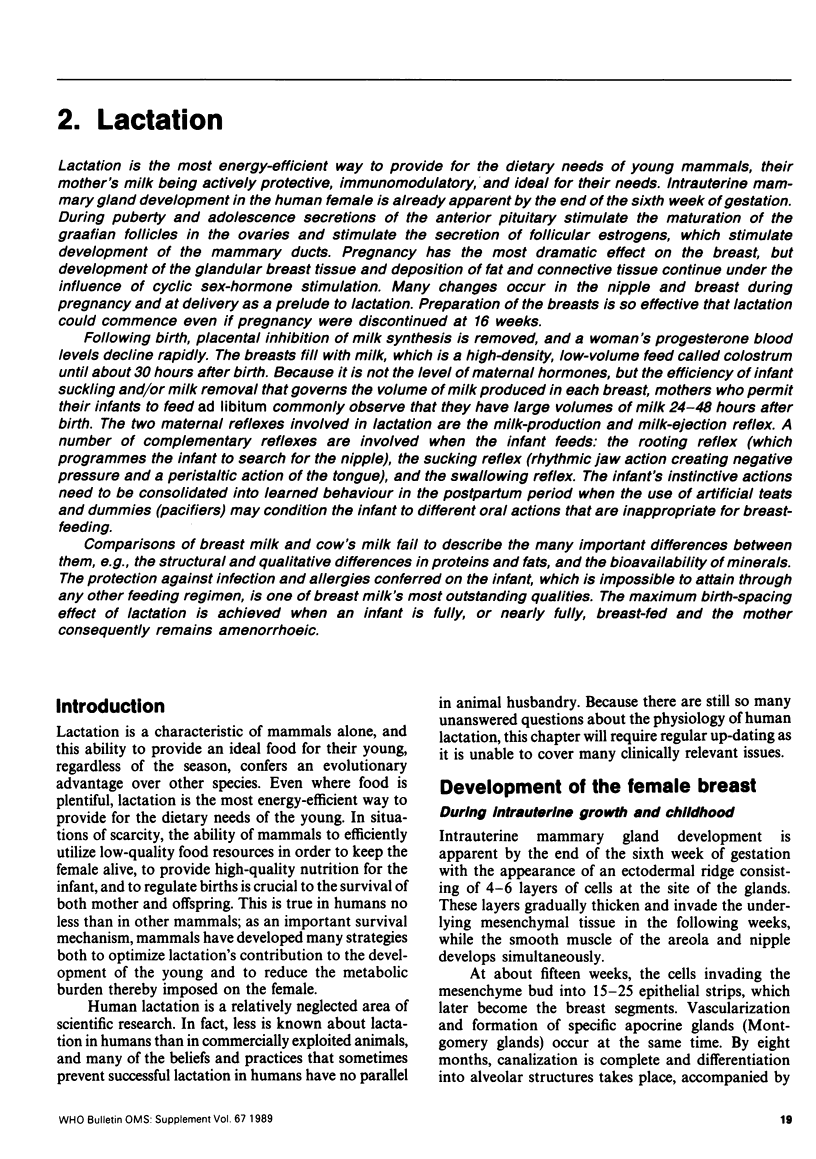
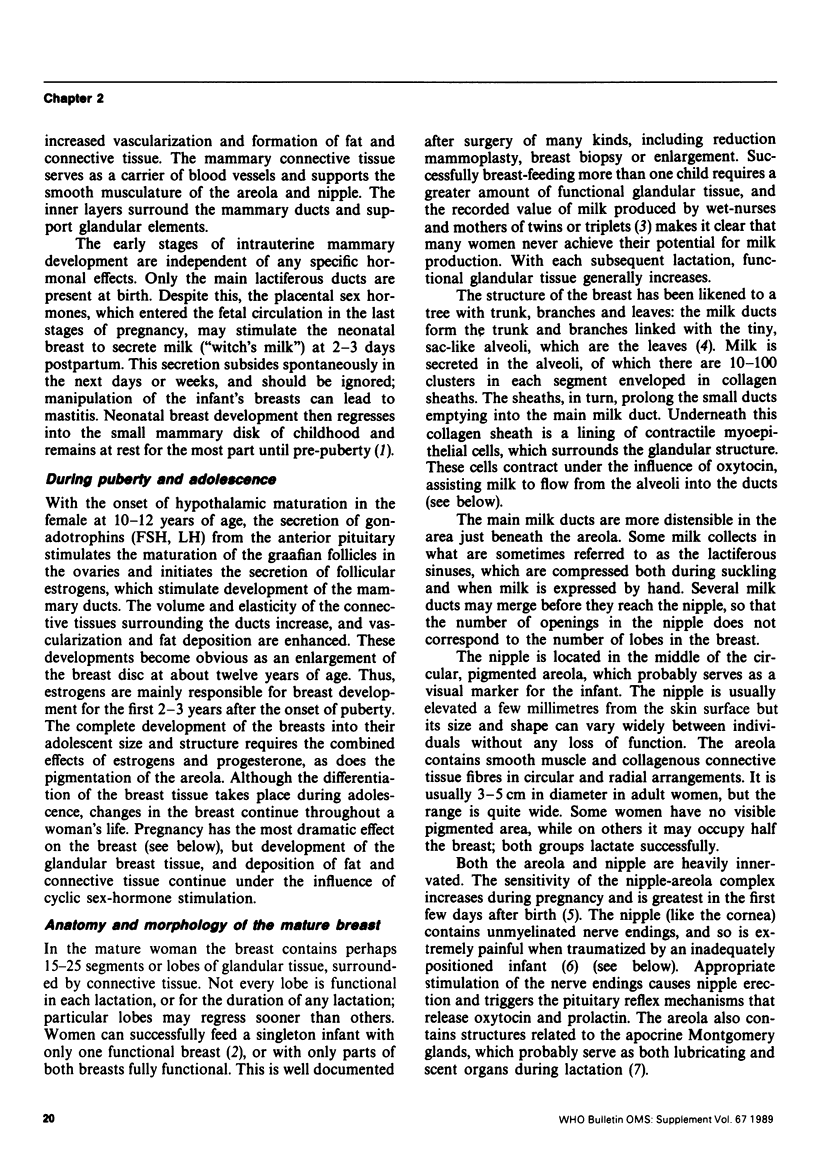
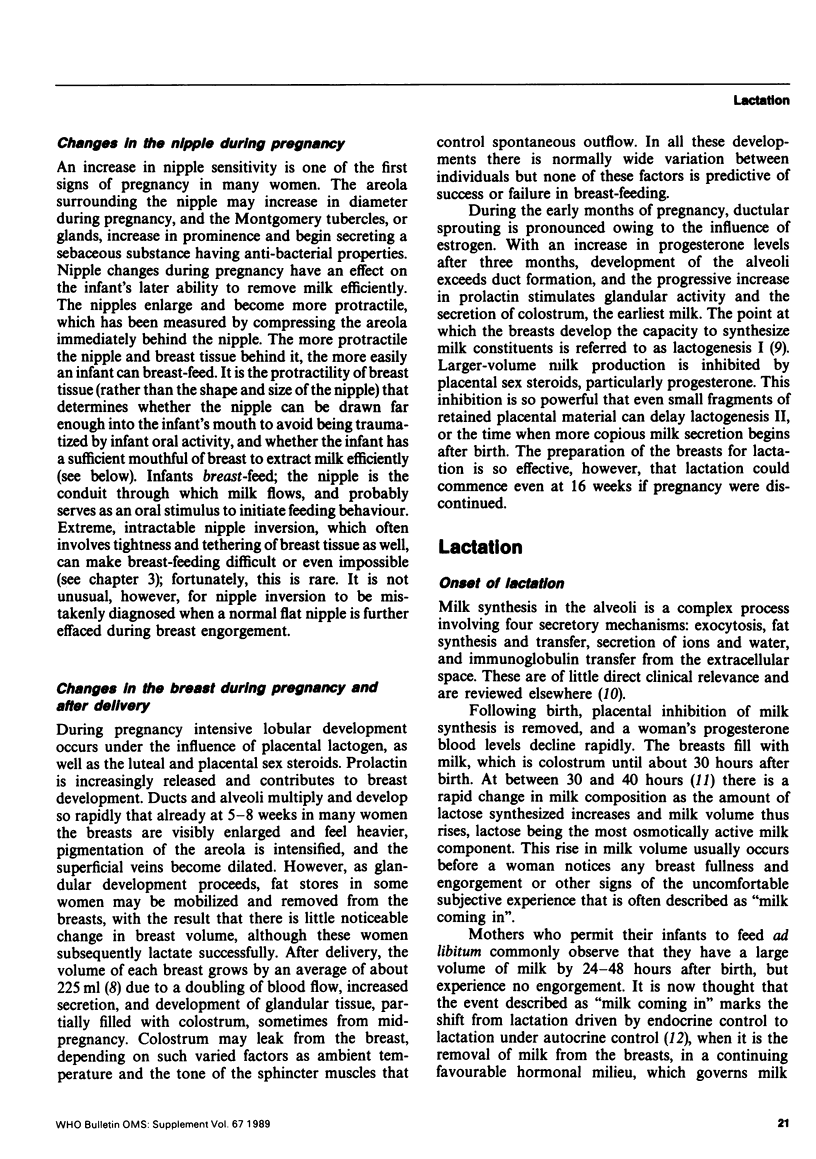
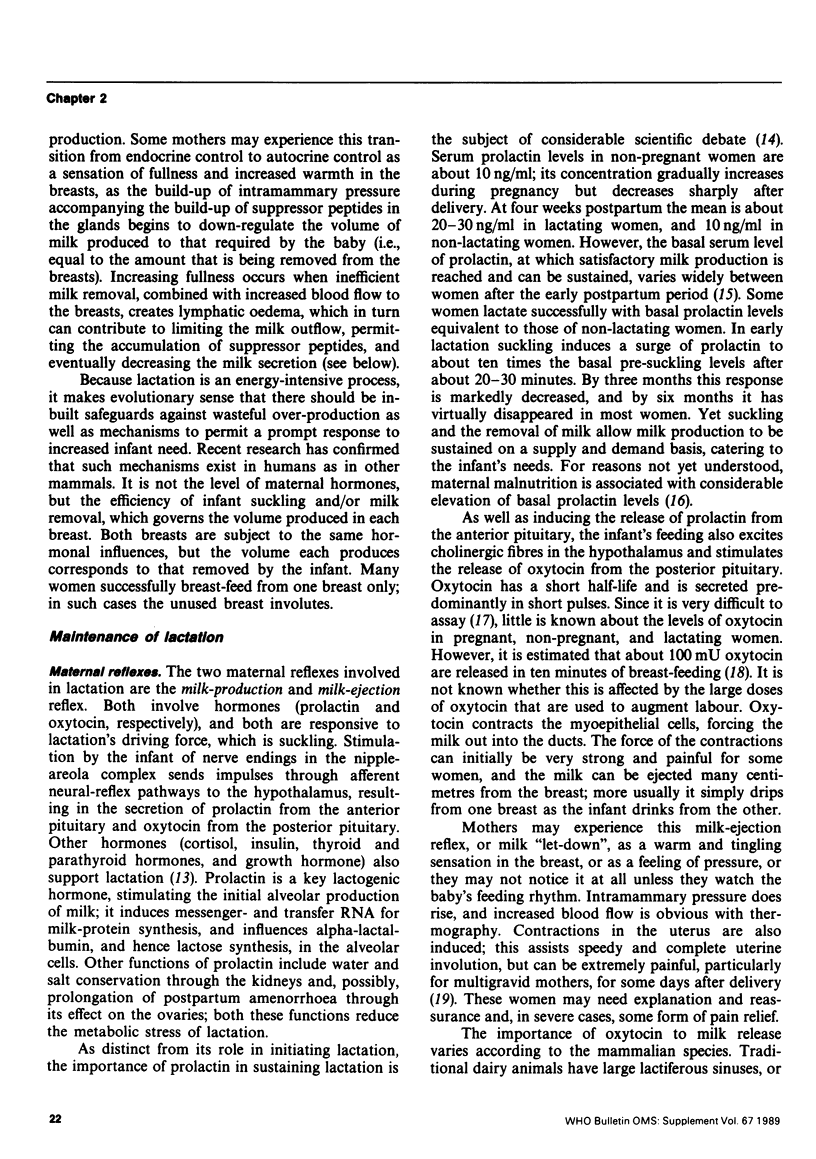
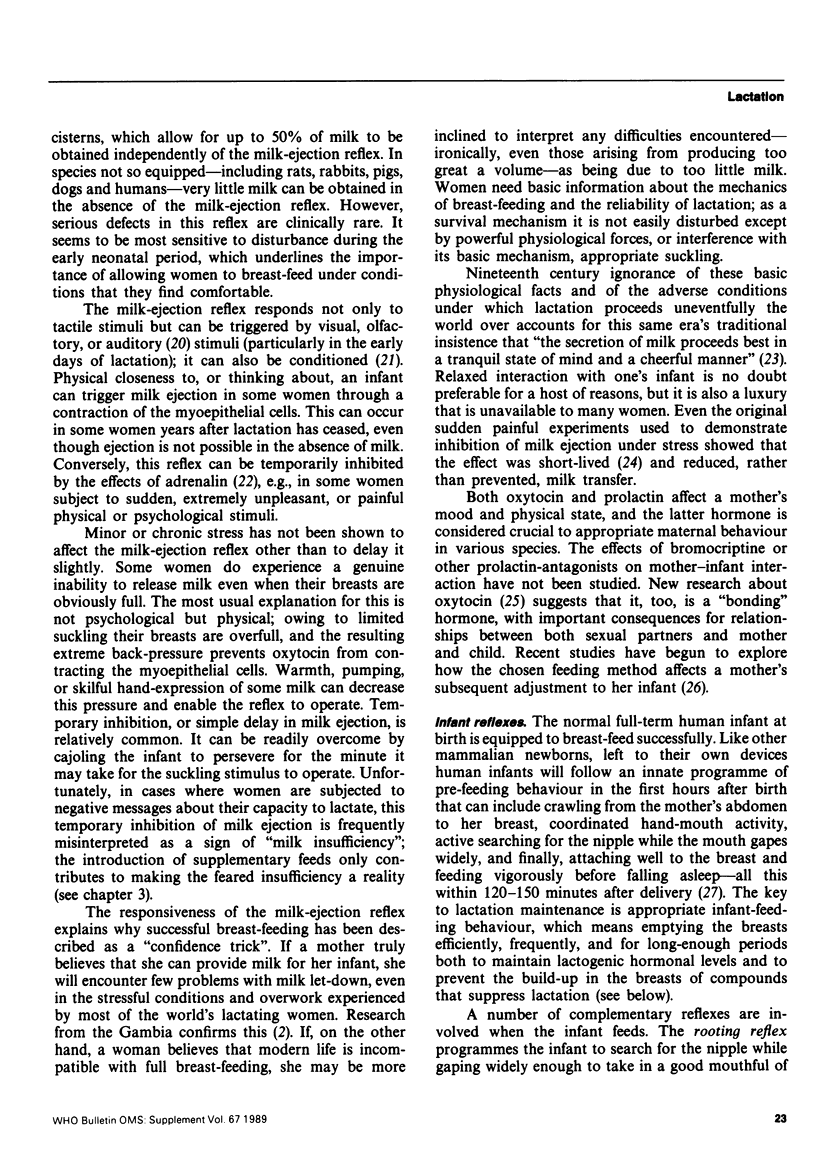
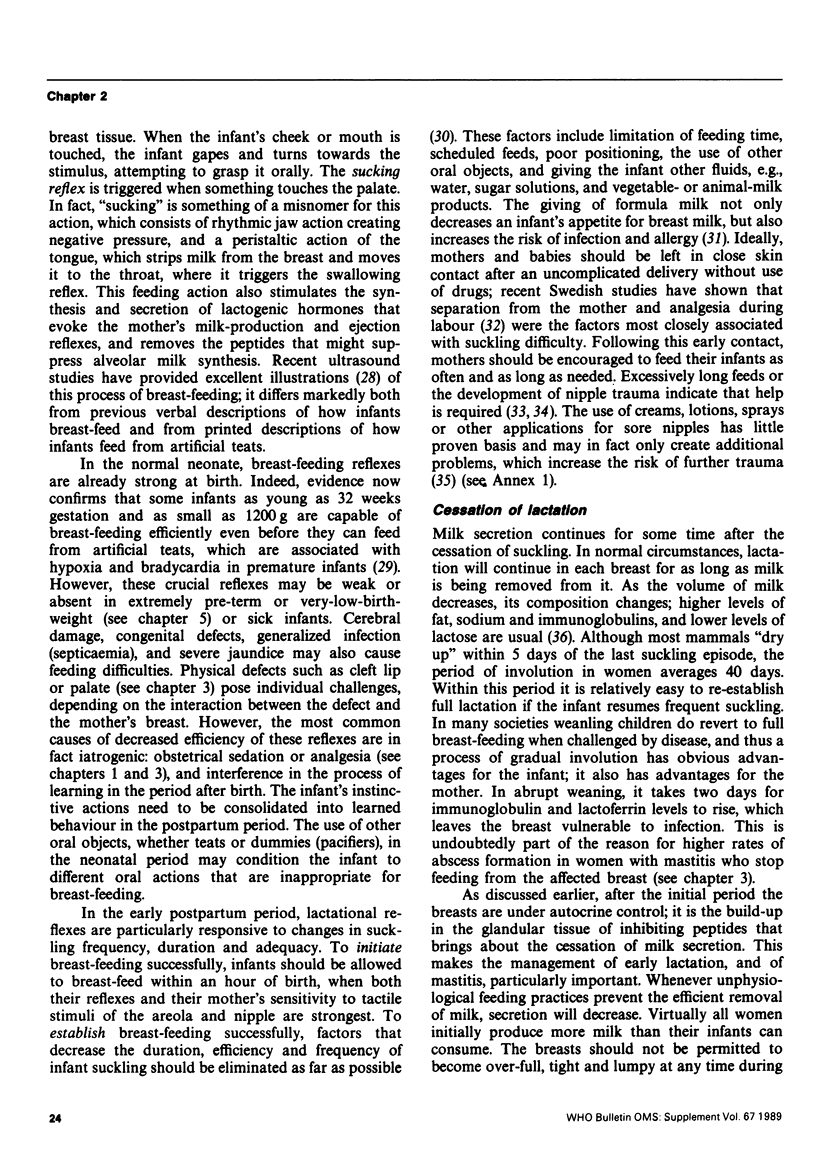
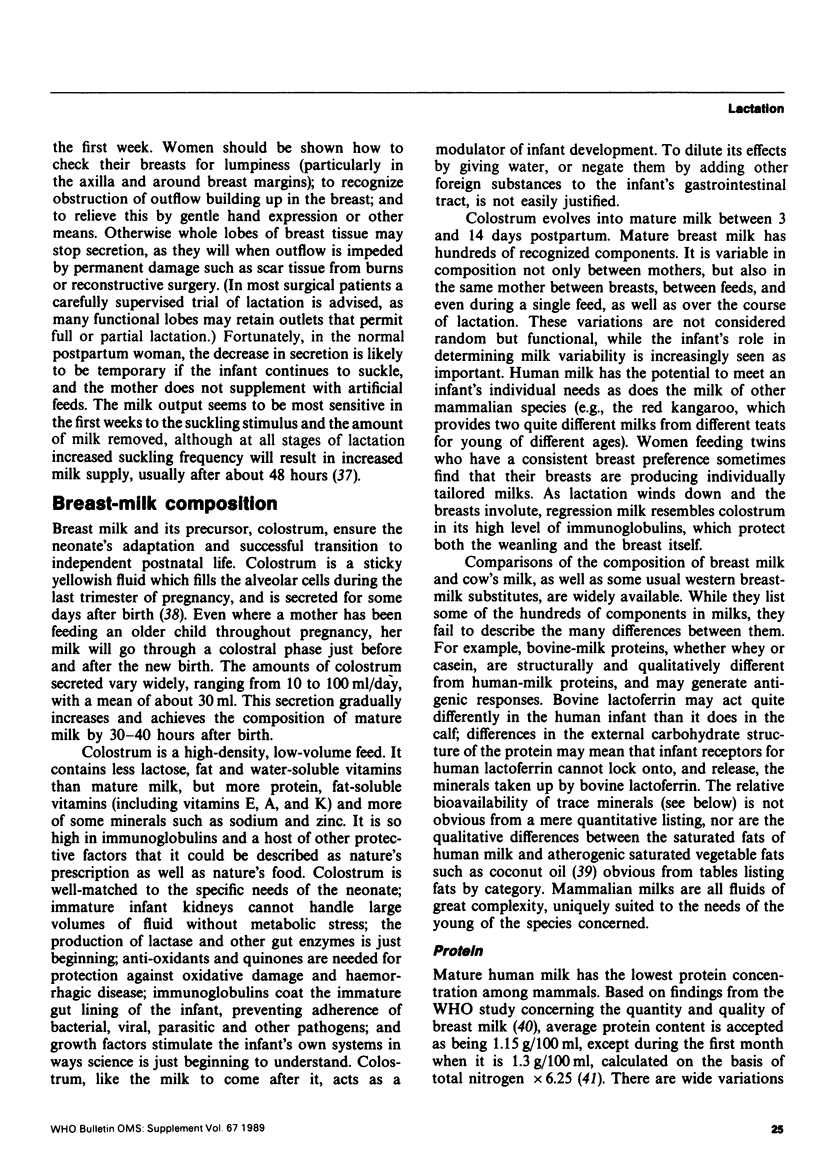
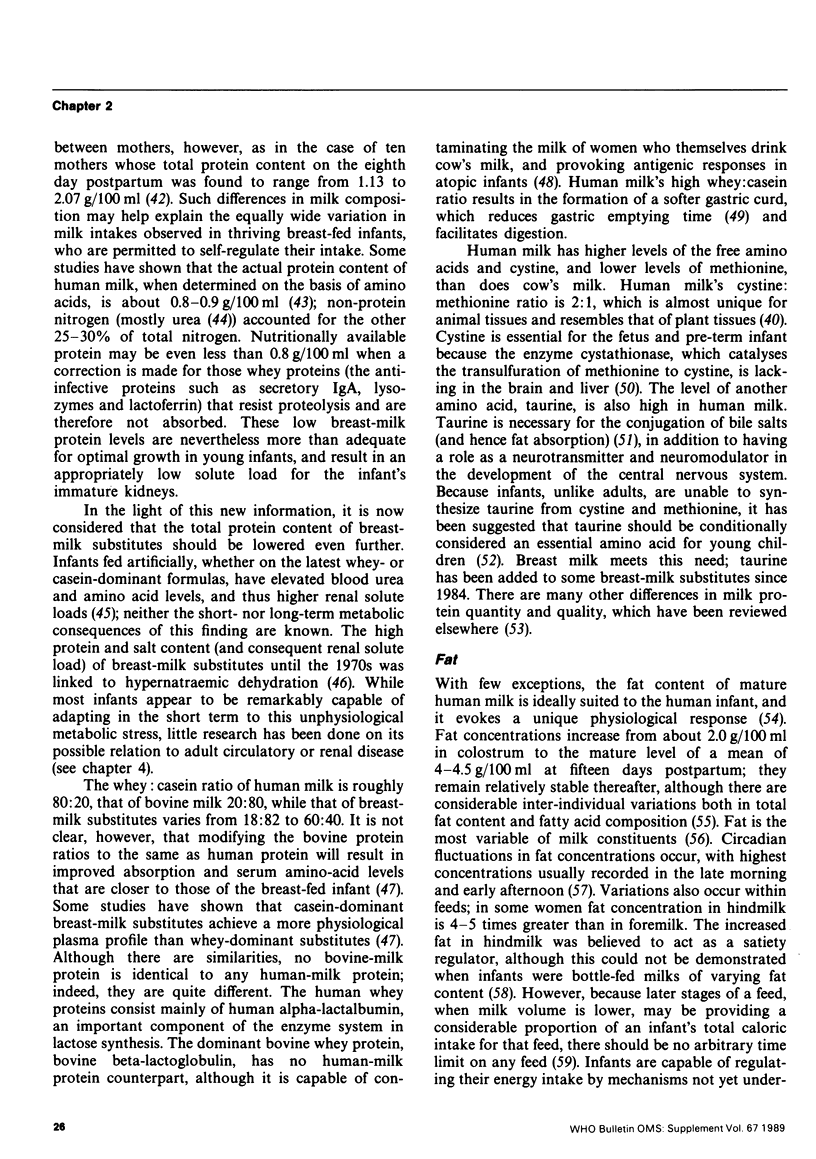
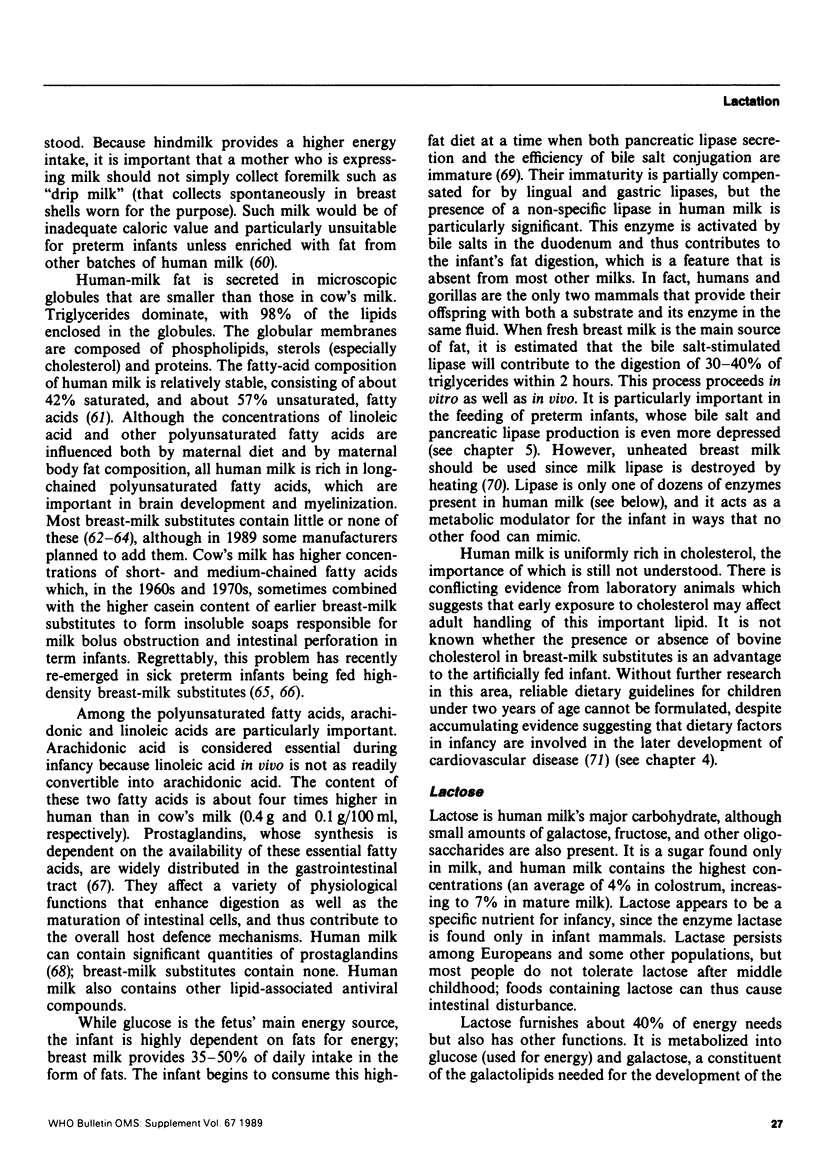
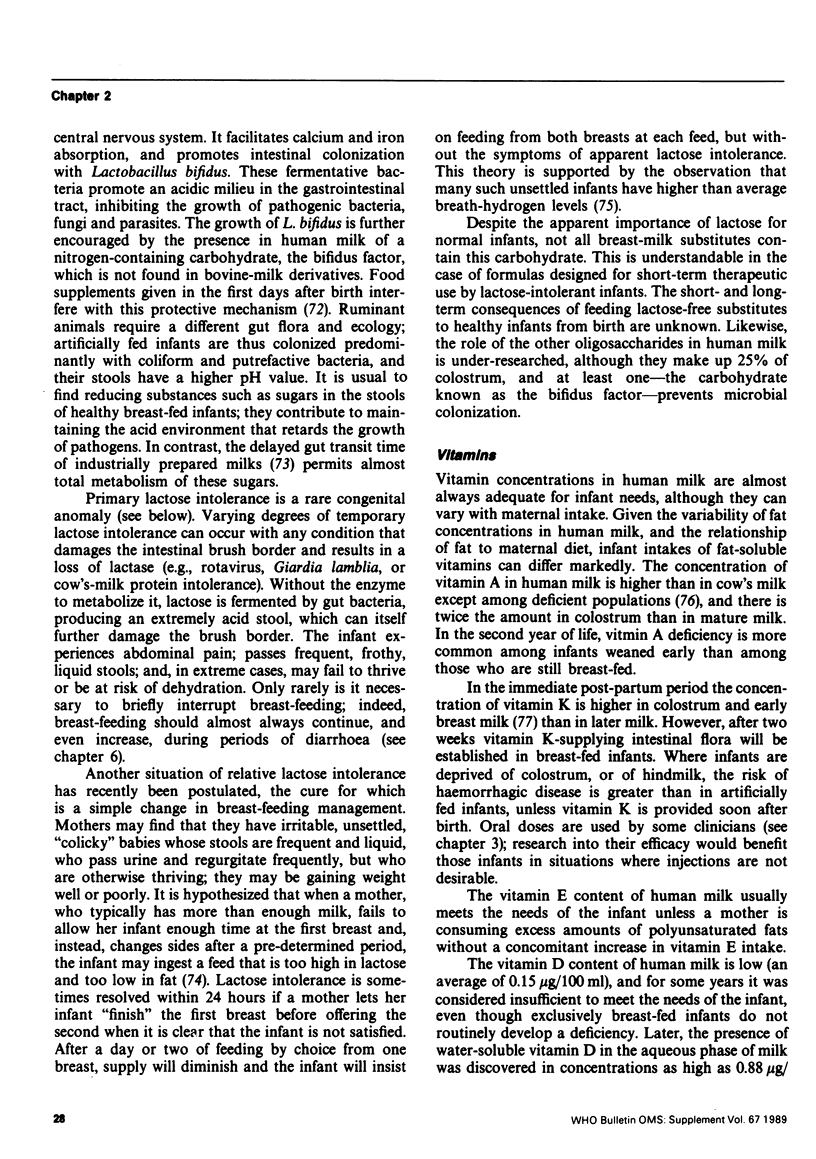
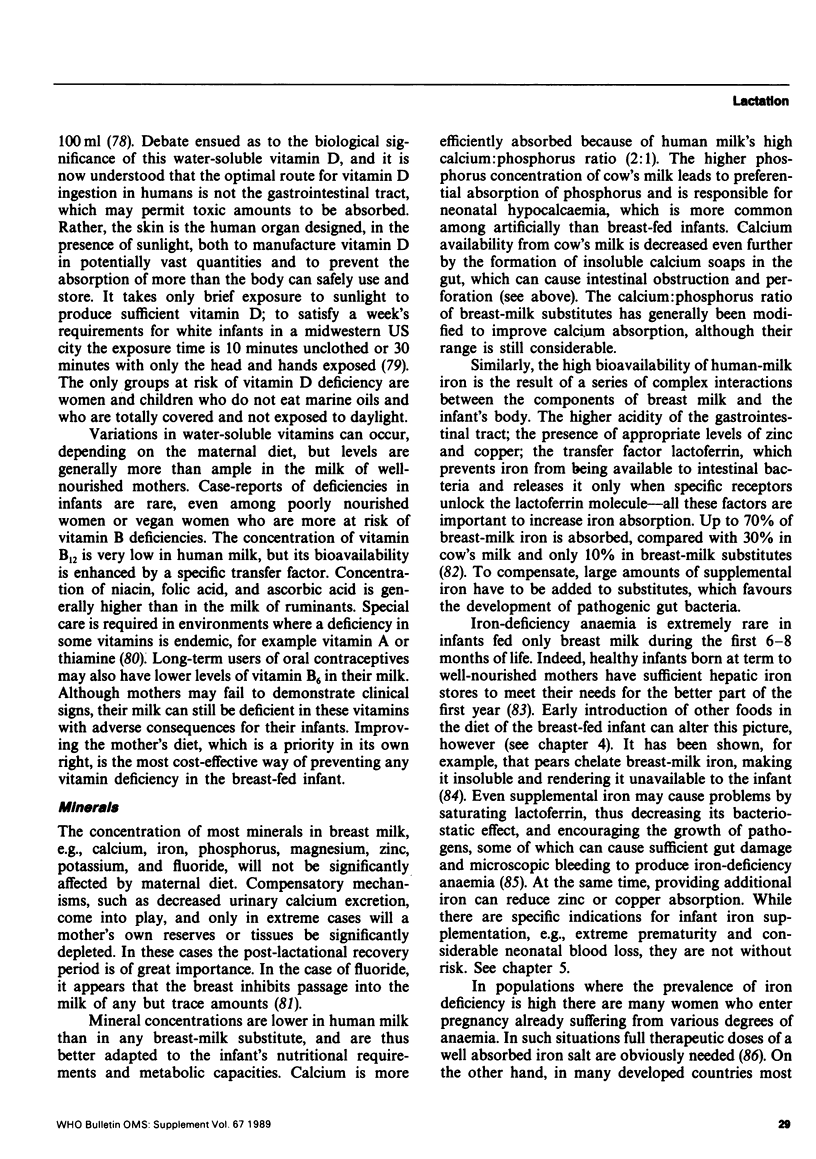
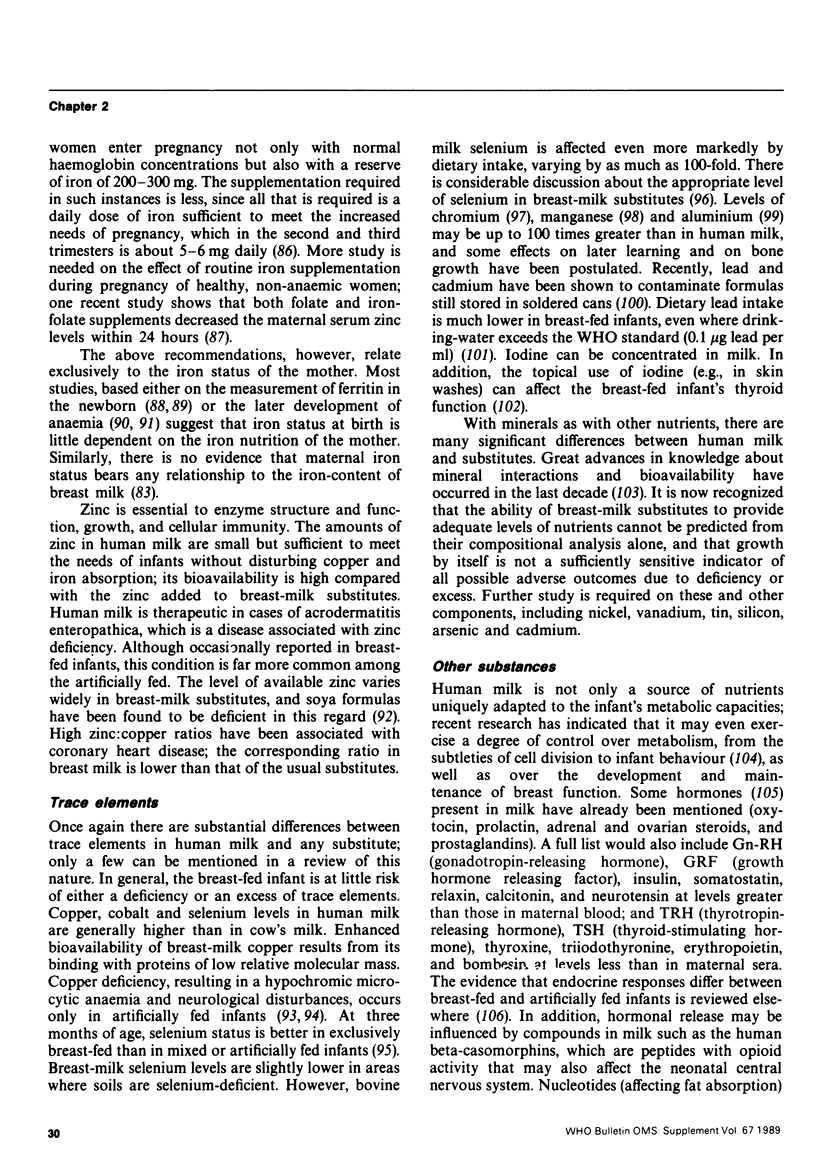
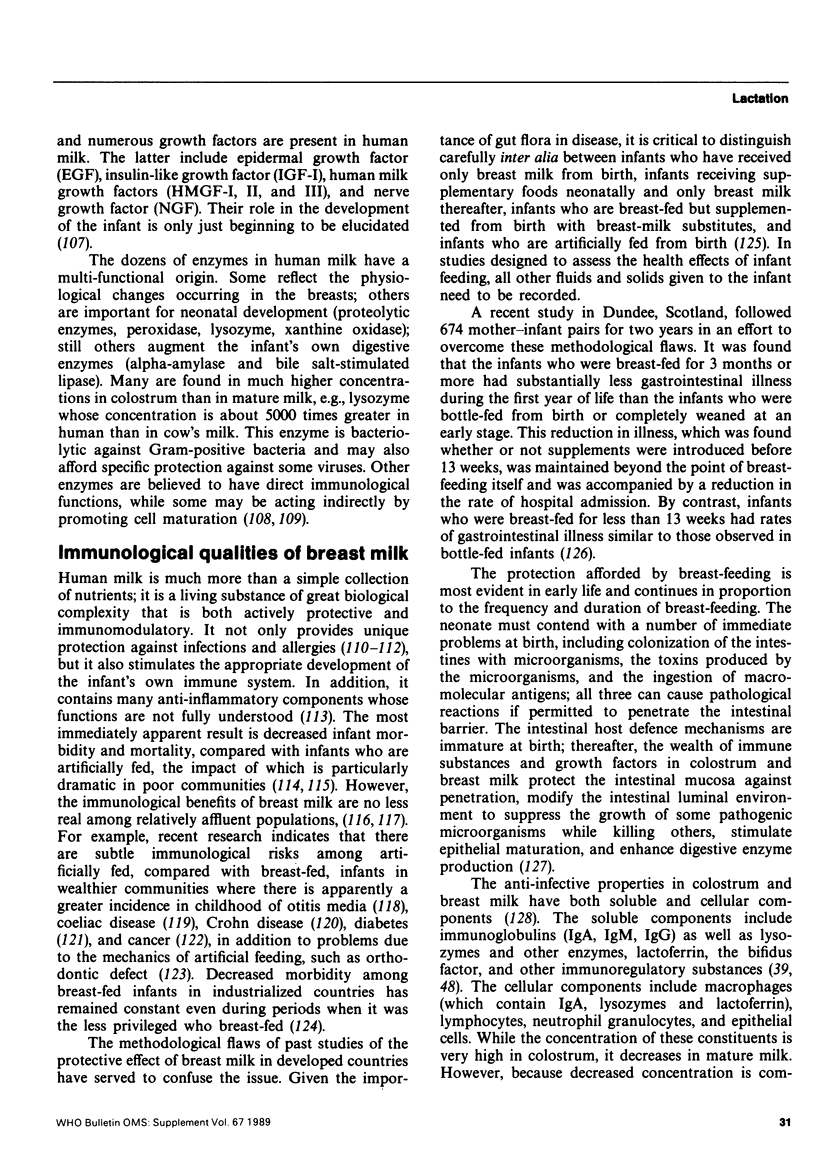
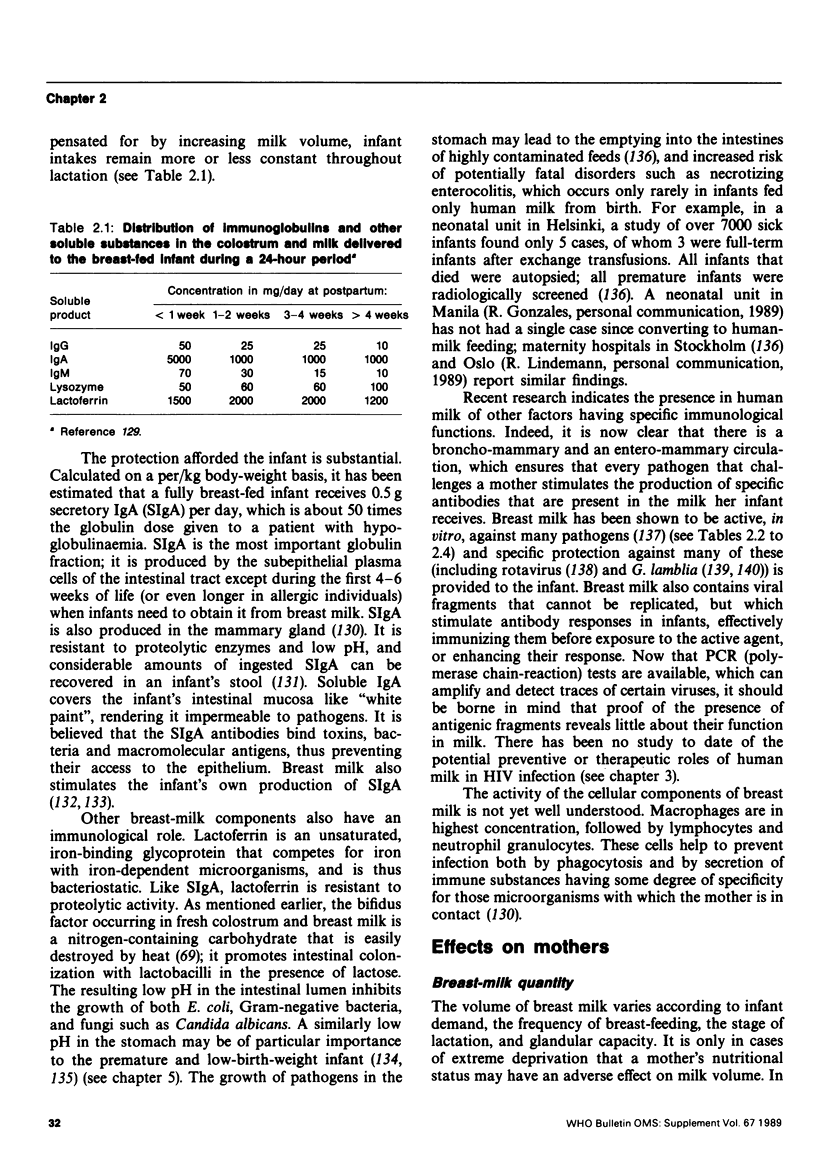
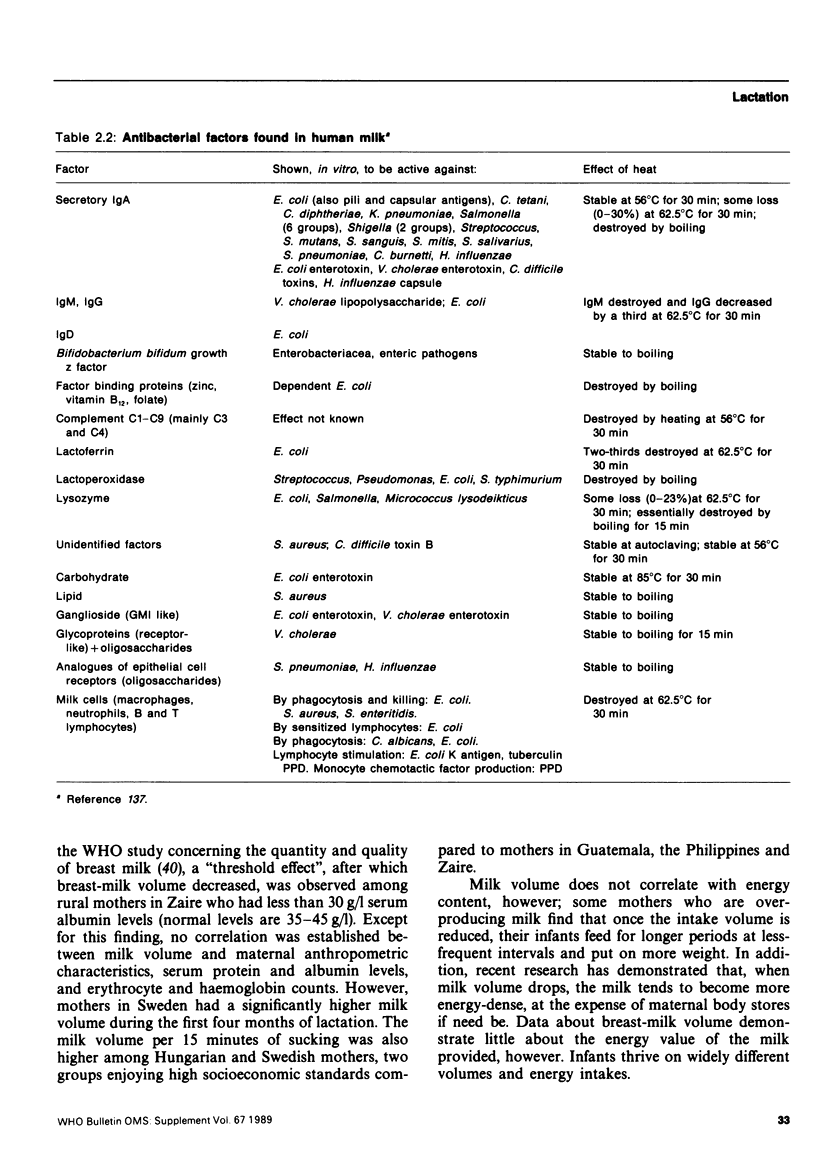
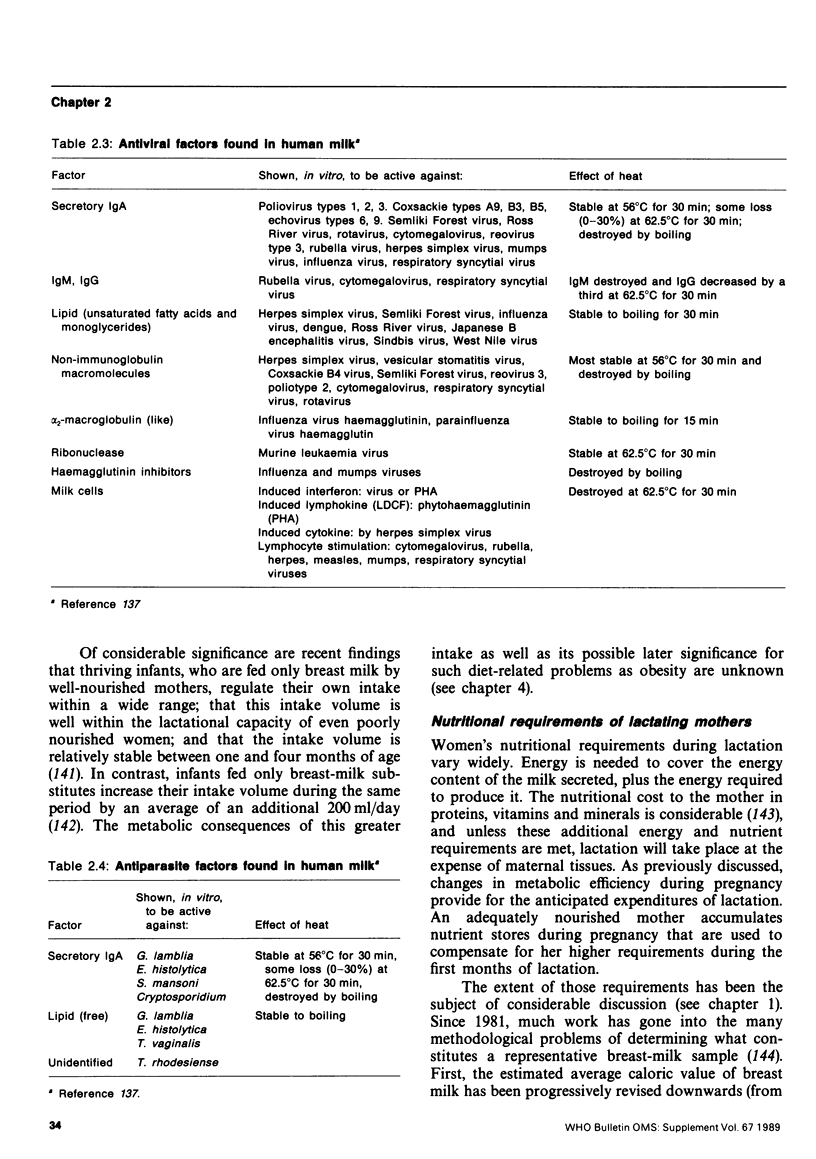
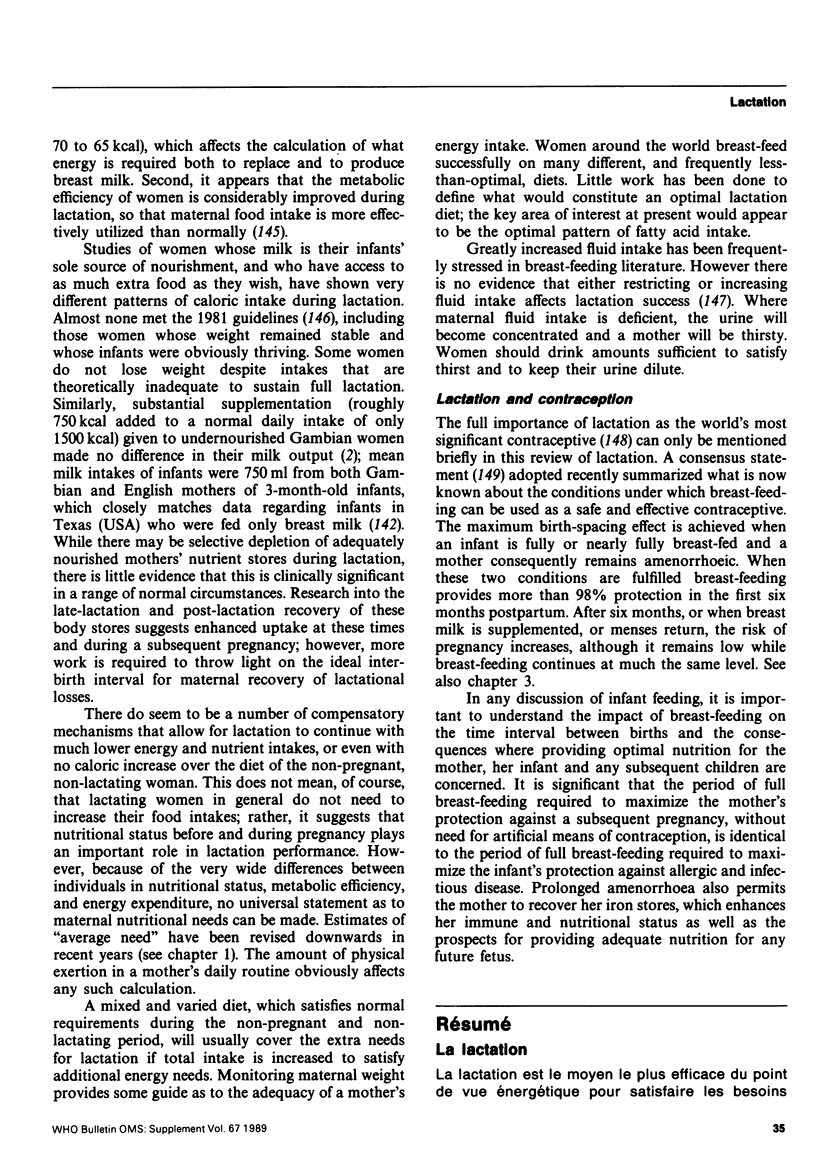
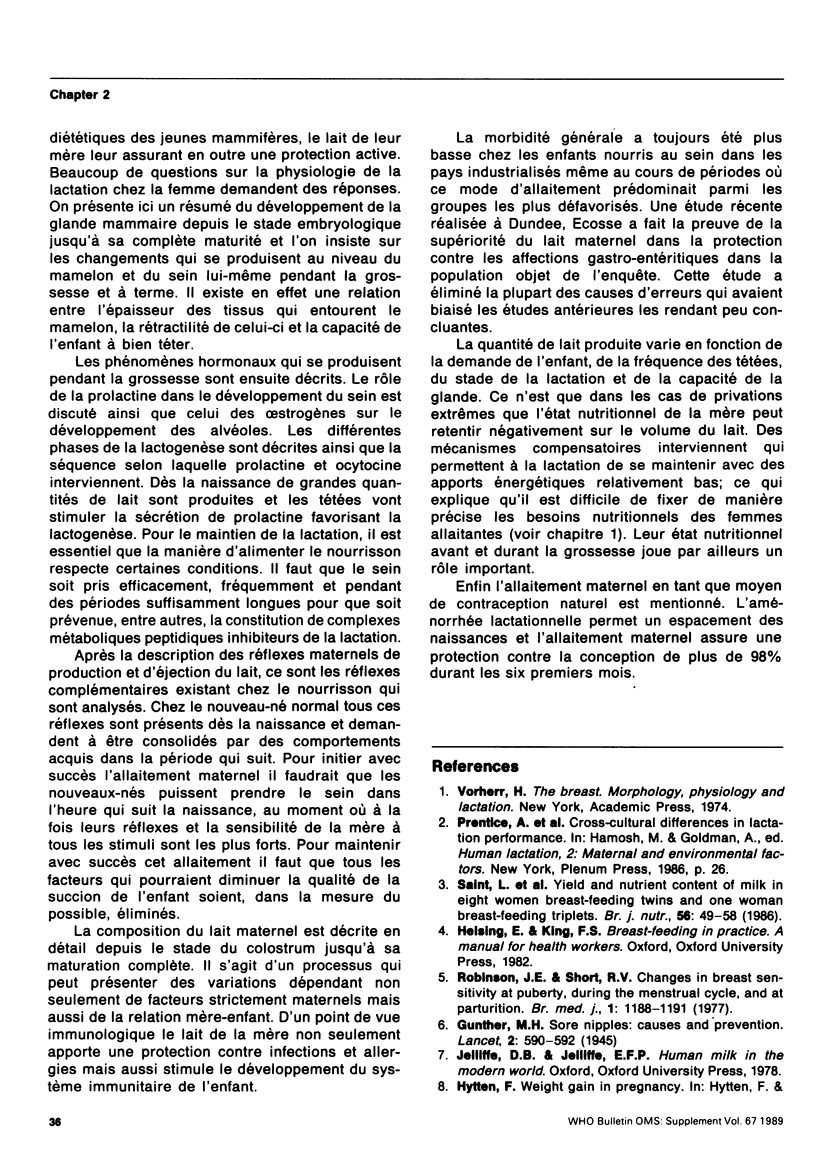
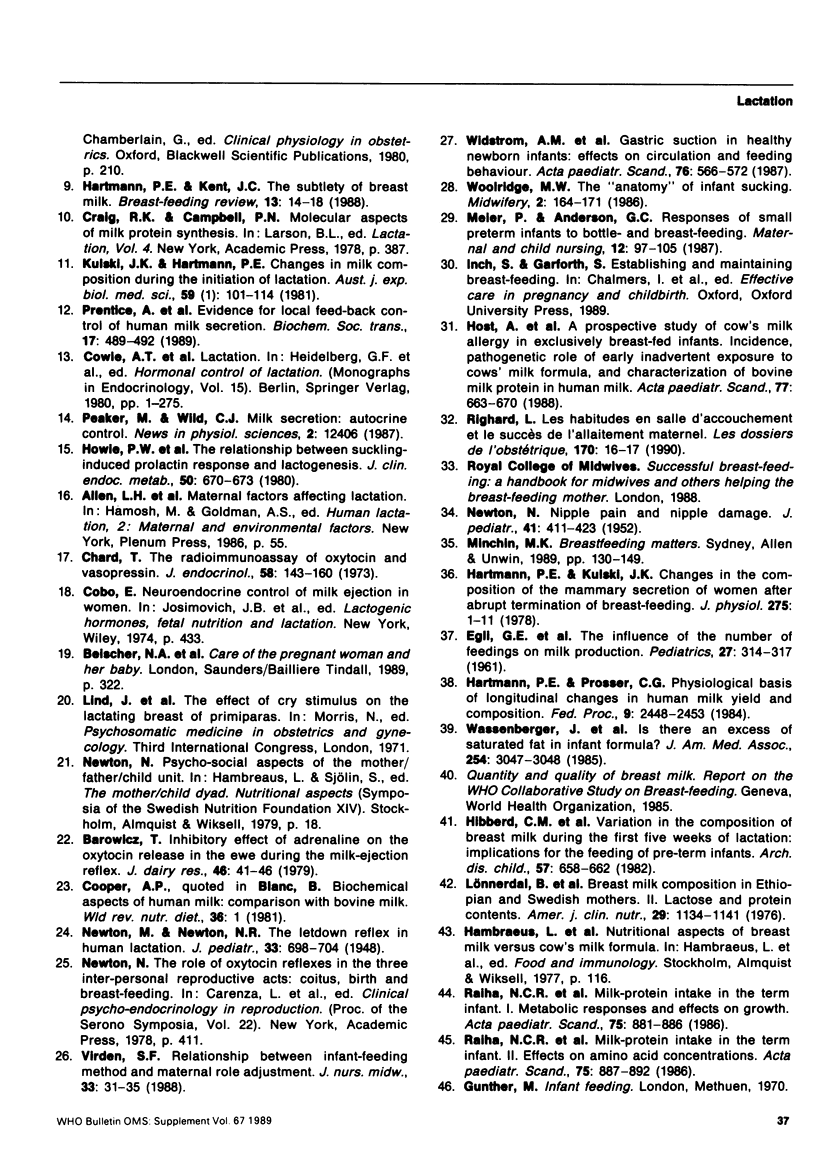
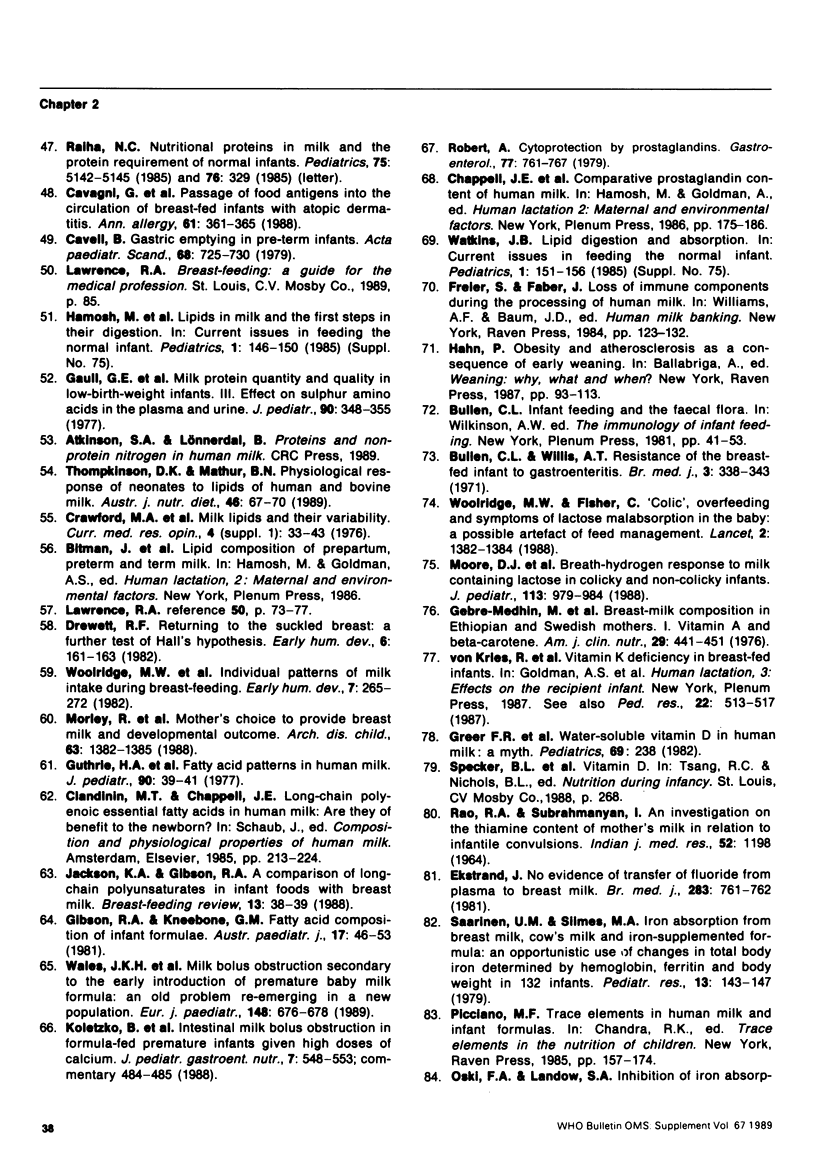
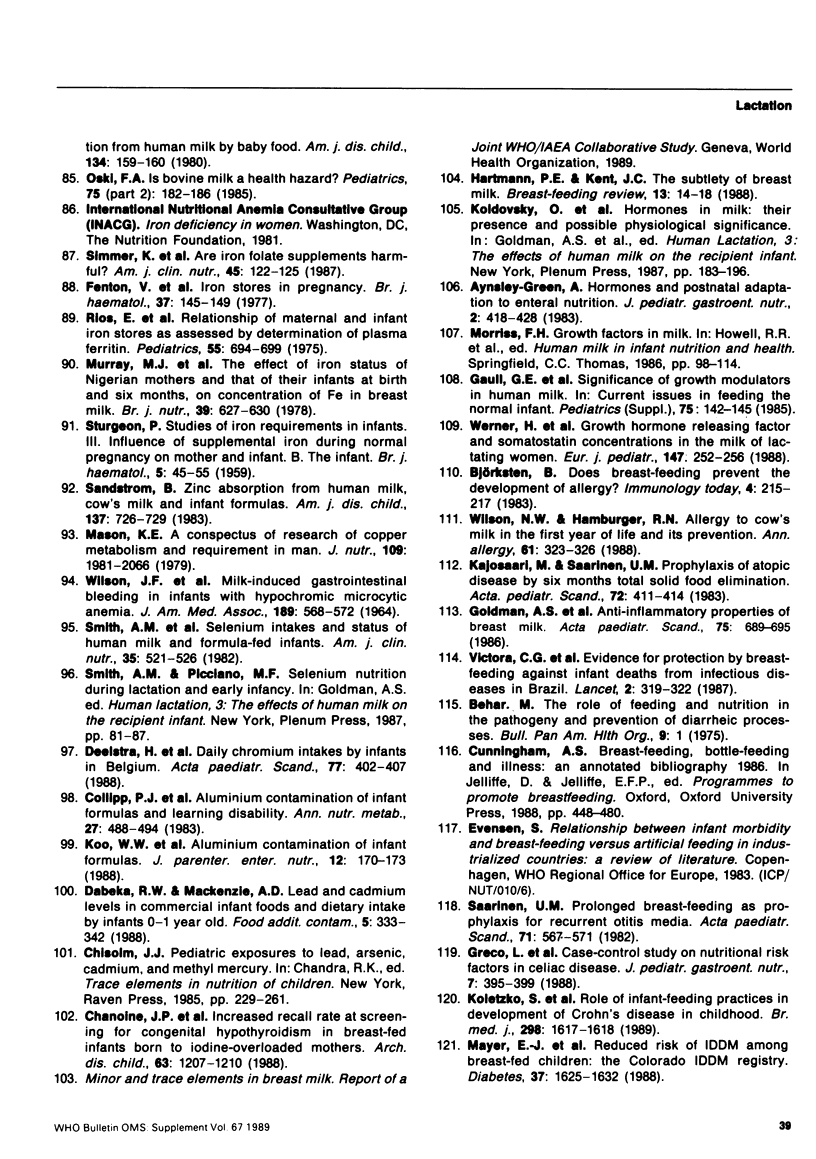
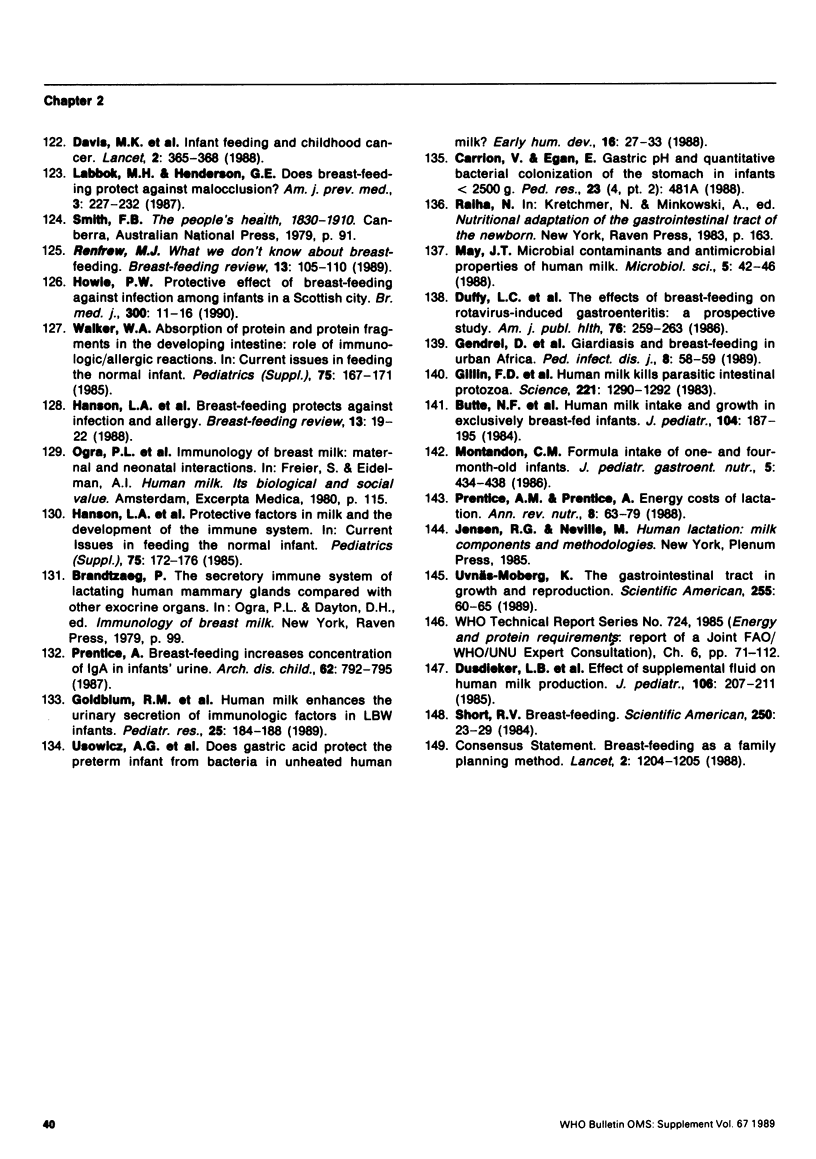
Selected References
These references are in PubMed. This may not be the complete list of references from this article.
- Bullen C. L., Willis A. T. Resistance of the breast-fed infant to gastroenteritis. Br Med J. 1971 Aug 7;3(5770):338–343. doi: 10.1136/bmj.3.5770.338. [DOI] [PMC free article] [PubMed] [Google Scholar]
- Butte N. F., Garza C., Smith E. O., Nichols B. L. Human milk intake and growth in exclusively breast-fed infants. J Pediatr. 1984 Feb;104(2):187–195. doi: 10.1016/s0022-3476(84)80990-7. [DOI] [PubMed] [Google Scholar]
- Chard T. The radioimmunoassay of oxytocin and vasopressin. J Endocrinol. 1973 Jul;58(1):143–160. doi: 10.1677/joe.0.0580143. [DOI] [PubMed] [Google Scholar]
- Dabeka R. W., McKenzie A. D. Lead and cadmium levels in commercial infant foods and dietary intake by infants 0-1 year old. Food Addit Contam. 1988 Jul-Sep;5(3):333–342. doi: 10.1080/02652038809373712. [DOI] [PubMed] [Google Scholar]
- Davis M. K., Savitz D. A., Graubard B. I. Infant feeding and childhood cancer. Lancet. 1988 Aug 13;2(8607):365–368. doi: 10.1016/s0140-6736(88)92835-8. [DOI] [PubMed] [Google Scholar]
- Deelstra H., van Schoor O., Robberecht H., Clara R., Eylenbosch W. Daily chromium intake by infants in Belgium. Acta Paediatr Scand. 1988 May;77(3):402–407. doi: 10.1111/j.1651-2227.1988.tb10667.x. [DOI] [PubMed] [Google Scholar]
- Drewett R. F. Returning to the suckled breast: a further test of Hall's hypothesis. Early Hum Dev. 1982 Apr;6(2):161–163. doi: 10.1016/0378-3782(82)90103-7. [DOI] [PubMed] [Google Scholar]
- Duffy L. C., Byers T. E., Riepenhoff-Talty M., La Scolea L. J., Zielezny M., Ogra P. L. The effects of infant feeding on rotavirus-induced gastroenteritis: a prospective study. Am J Public Health. 1986 Mar;76(3):259–263. doi: 10.2105/ajph.76.3.259. [DOI] [PMC free article] [PubMed] [Google Scholar]
- EGLI G. E., EGLI N. S., NEWTON M. The influence of the number of breast feedings on milk production. Pediatrics. 1961 Feb;27:314–317. [PubMed] [Google Scholar]
- Ekstrand J., Boreus L. O., de Chateau P. No evidence of transfer of fluoride from plasma to breast milk. Br Med J (Clin Res Ed) 1981 Sep 19;283(6294):761–762. doi: 10.1136/bmj.283.6294.761. [DOI] [PMC free article] [PubMed] [Google Scholar]
- Fenton V., Cavill I., Fisher J. Iron stores in pregnancy. Br J Haematol. 1977 Sep;37(1):145–149. [PubMed] [Google Scholar]
- Gaull G. E., Rassin D. K., Räihä N. C., Heinonen K. Milk protein quantity and quality in low-birth-weight infants. III. Effects on sulfur amino acids in plasma and urine. J Pediatr. 1977 Mar;90(3):348–355. doi: 10.1016/s0022-3476(77)80692-6. [DOI] [PubMed] [Google Scholar]
- Gaull G. E., Wright C. E., Isaacs C. E. Significance of growth modulators in human milk. Pediatrics. 1985 Jan;75(1 Pt 2):142–145. [PubMed] [Google Scholar]
- Gebre-Medhin M., Vahlquist A., Hofvander Y., Uppsäll L., Vahlquist B. Breast milk composition in Ethiopian and Swedish mothers. I. Vitamin A and beta-carotene. Am J Clin Nutr. 1976 Apr;29(4):441–451. doi: 10.1093/ajcn/29.4.441. [DOI] [PubMed] [Google Scholar]
- Gendrel D., Richard-Lenoble D., Kombila M., Gendrel C., Baziomo J. M. Giardiasis and breast-feeding in urban Africa. Pediatr Infect Dis J. 1989 Jan;8(1):58–59. doi: 10.1097/00006454-198901000-00018. [DOI] [PubMed] [Google Scholar]
- Gibson R. A., Kneebone G. M. Fatty acid composition of infant formulae. Aust Paediatr J. 1981 Mar;17(1):46–53. doi: 10.1111/j.1440-1754.1981.tb00014.x. [DOI] [PubMed] [Google Scholar]
- Goldblum R. M., Schanler R. J., Garza C., Goldman A. S. Human milk feeding enhances the urinary excretion of immunologic factors in low birth weight infants. Pediatr Res. 1989 Feb;25(2):184–188. doi: 10.1203/00006450-198902000-00021. [DOI] [PubMed] [Google Scholar]
- Goldman A. S., Thorpe L. W., Goldblum R. M., Hanson L. A. Anti-inflammatory properties of human milk. Acta Paediatr Scand. 1986 Sep;75(5):689–695. doi: 10.1111/j.1651-2227.1986.tb10275.x. [DOI] [PubMed] [Google Scholar]
- Greer F. R., Reeve L. E., Chesney R. W., DeLuca H. F. Water-soluble vitamin D in human milk: a myth. Pediatrics. 1982 Feb;69(2):238–238. [PubMed] [Google Scholar]
- Guthrie H. A., Picciano M. F., Sheehe D. Fatty acid patterns of human milk. J Pediatr. 1977 Jan;90(1):39–41. doi: 10.1016/s0022-3476(77)80761-0. [DOI] [PubMed] [Google Scholar]
- Hartmann P. E., Kulski J. K. Changes in the composition of the mammary secretion of women after abrupt termination of breast feeding. J Physiol. 1978 Feb;275:1–11. doi: 10.1113/jphysiol.1978.sp012173. [DOI] [PMC free article] [PubMed] [Google Scholar]
- Høst A., Husby S., Osterballe O. A prospective study of cow's milk allergy in exclusively breast-fed infants. Incidence, pathogenetic role of early inadvertent exposure to cow's milk formula, and characterization of bovine milk protein in human milk. Acta Paediatr Scand. 1988 Sep;77(5):663–670. doi: 10.1111/j.1651-2227.1988.tb10727.x. [DOI] [PubMed] [Google Scholar]
- Koletzko B., Tangermann R., von Kries R., Stannigel H., Willberg B., Radde I., Schmidt E. Intestinal milk-bolus obstruction in formula-fed premature infants given high doses of calcium. J Pediatr Gastroenterol Nutr. 1988 Jul-Aug;7(4):548–553. doi: 10.1097/00005176-198807000-00012. [DOI] [PubMed] [Google Scholar]
- Koletzko S., Sherman P., Corey M., Griffiths A., Smith C. Role of infant feeding practices in development of Crohn's disease in childhood. BMJ. 1989 Jun 17;298(6688):1617–1618. doi: 10.1136/bmj.298.6688.1617. [DOI] [PMC free article] [PubMed] [Google Scholar]
- Koo W. W., Kaplan L. A., Krug-Wispe S. K. Aluminum contamination of infant formulas. JPEN J Parenter Enteral Nutr. 1988 Mar-Apr;12(2):170–173. doi: 10.1177/0148607188012002170. [DOI] [PubMed] [Google Scholar]
- Labbok M. H., Hendershot G. E. Does breast-feeding protect against malocclusion? An analysis of the 1981 Child Health Supplement to the National Health Interview Survey. Am J Prev Med. 1987 Jul-Aug;3(4):227–232. [PubMed] [Google Scholar]
- Mason K. E. A conspectus of research on copper metabolism and requirements of man. J Nutr. 1979 Nov;109(11):1979–2066. doi: 10.1093/jn/109.11.1979. [DOI] [PubMed] [Google Scholar]
- Mayer E. J., Hamman R. F., Gay E. C., Lezotte D. C., Savitz D. A., Klingensmith G. J. Reduced risk of IDDM among breast-fed children. The Colorado IDDM Registry. Diabetes. 1988 Dec;37(12):1625–1632. doi: 10.2337/diab.37.12.1625. [DOI] [PubMed] [Google Scholar]
- Meier P., Anderson G. C. Responses of small preterm infants to bottle- and breast-feeding. MCN Am J Matern Child Nurs. 1987 Mar-Apr;12(2):97–105. doi: 10.1097/00005721-198703000-00006. [DOI] [PubMed] [Google Scholar]
- Montandon C. M., Wills C., Garza C., Smith E. O., Nichols B. L. Formula intake of 1- and 4-month-old infants. J Pediatr Gastroenterol Nutr. 1986 May-Jun;5(3):434–438. doi: 10.1097/00005176-198605000-00017. [DOI] [PubMed] [Google Scholar]
- Moore D. J., Robb T. A., Davidson G. P. Breath hydrogen response to milk containing lactose in colicky and noncolicky infants. J Pediatr. 1988 Dec;113(6):979–984. doi: 10.1016/s0022-3476(88)80567-5. [DOI] [PubMed] [Google Scholar]
- Morley R., Cole T. J., Powell R., Lucas A. Mother's choice to provide breast milk and developmental outcome. Arch Dis Child. 1988 Nov;63(11):1382–1385. doi: 10.1136/adc.63.11.1382. [DOI] [PMC free article] [PubMed] [Google Scholar]
- Murray M. J., Murray A. B., Murray N. J., Murray M. B. The effect of iron status of Nigerien mothers on that of their infants at birth and 6 months, and on the concentration of Fe in breast milk. Br J Nutr. 1978 May;39(3):627–630. doi: 10.1079/bjn19780077. [DOI] [PubMed] [Google Scholar]
- NEWTON M., NEWTON N. R. The let-down reflex in human lactation. J Pediatr. 1948 Dec;33(6):698–704. doi: 10.1016/s0022-3476(48)80075-2. [DOI] [PubMed] [Google Scholar]
- NEWTON N. Nipple pain and nipple damage; problems in the management of breast feeding. J Pediatr. 1952 Oct;41(4):411–423. doi: 10.1016/s0022-3476(52)80124-6. [DOI] [PubMed] [Google Scholar]
- Prentice A. Breast feeding increases concentrations of IgA in infants' urine. Arch Dis Child. 1987 Aug;62(8):792–795. doi: 10.1136/adc.62.8.792. [DOI] [PMC free article] [PubMed] [Google Scholar]
- RAO R. R., SUBRAHMANYAM I. AN INVESTIGATION ON THE THIAMINE CONTENT OF MOTHER'S MILK IN RELATION TO INFANTILE CONVULSIONS. Indian J Med Res. 1964 Nov;52:1198–1201. [PubMed] [Google Scholar]
- Rios E., Lipschitz D. A., Cook J. D., Smith N. J. Relationship of maternal and infant iron stores as assessed by determination of plasma ferritin. Pediatrics. 1975 May;55(5):694–699. [PubMed] [Google Scholar]
- Robinson J. E., Short R. V. Changes in breast sensitivity at puberty, during the menstrual cycle, and at parturition. Br Med J. 1977 May 7;1(6070):1188–1191. doi: 10.1136/bmj.1.6070.1188. [DOI] [PMC free article] [PubMed] [Google Scholar]
- STURGEON P. Studies of iron requirements in infants. III. Influence of supplemental iron during normal pregnancy on mother and infant. B. The infant. Br J Haematol. 1959 Jan;5(1):45–55. doi: 10.1111/j.1365-2141.1959.tb04012.x. [DOI] [PubMed] [Google Scholar]
- Saint L., Maggiore P., Hartmann P. E. Yield and nutrient content of milk in eight women breast-feeding twins and one woman breast-feeding triplets. Br J Nutr. 1986 Jul;56(1):49–58. doi: 10.1079/bjn19860084. [DOI] [PubMed] [Google Scholar]
- Sandström B., Cederblad A., Lönnerdal B. Zinc absorption from human milk, cow's milk, and infant formulas. Am J Dis Child. 1983 Aug;137(8):726–729. doi: 10.1001/archpedi.1983.02140340010002. [DOI] [PubMed] [Google Scholar]
- Simmer K., Iles C. A., James C., Thompson R. P. Are iron-folate supplements harmful? Am J Clin Nutr. 1987 Jan;45(1):122–125. doi: 10.1093/ajcn/45.1.122. [DOI] [PubMed] [Google Scholar]
- Smith A. M., Picciano M. F., Milner J. A. Selenium intakes and status of human milk and formula fed infants. Am J Clin Nutr. 1982 Mar;35(3):521–526. doi: 10.1093/ajcn/35.3.521. [DOI] [PubMed] [Google Scholar]
- Usowicz A. G., Dab S. B., Emery J. R., McCann E. M., Brady J. P. Does gastric acid protect the preterm infant from bacteria in unheated human milk? Early Hum Dev. 1988 Jan;16(1):27–33. doi: 10.1016/0378-3782(88)90084-9. [DOI] [PubMed] [Google Scholar]
- Victora C. G., Smith P. G., Vaughan J. P., Nobre L. C., Lombardi C., Teixeira A. M., Fuchs S. M., Moreira L. B., Gigante L. P., Barros F. C. Evidence for protection by breast-feeding against infant deaths from infectious diseases in Brazil. Lancet. 1987 Aug 8;2(8554):319–322. doi: 10.1016/s0140-6736(87)90902-0. [DOI] [PubMed] [Google Scholar]
- WILSON J. F., HEINER D. C., LAHEY M. E. MILK-INDUCED GASTROINTESTINAL BLEEDING IN INFANTS WITH HYPOCHROMIC MICROCYTIC ANEMIA. JAMA. 1964 Aug 17;189:568–572. doi: 10.1001/jama.1964.03070070040010. [DOI] [PubMed] [Google Scholar]
- Wales J. K., Milford D., Okorie N. M. Milk bolus obstruction secondary to the early introduction of premature baby milk formula: an old syndrome re-emerging in a new population. Eur J Pediatr. 1989 Jun;148(7):676–678. doi: 10.1007/BF00441532. [DOI] [PubMed] [Google Scholar]
- Walker W. A. Absorption of protein and protein fragments in the developing intestine: role in immunologic/allergic reactions. Pediatrics. 1985 Jan;75(1 Pt 2):167–171. [PubMed] [Google Scholar]
- Werner H., Katz P., Fridkin M., Koch Y., Levine S. Growth hormone releasing factor and somatostatin concentrations in the milk of lactating women. Eur J Pediatr. 1988 Apr;147(3):252–256. doi: 10.1007/BF00442690. [DOI] [PubMed] [Google Scholar]
- Wilson N. W., Hamburger R. N. Allergy to cow's milk in the first year of life and its prevention. Ann Allergy. 1988 Nov;61(5):323–327. [PubMed] [Google Scholar]


